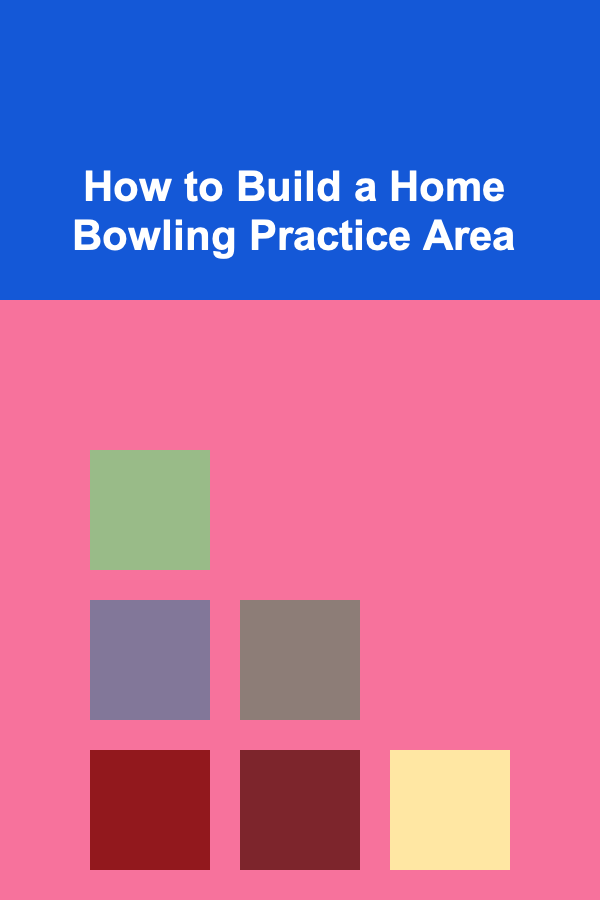
How to Build a Home Bowling Practice Area
ebook include PDF & Audio bundle (Micro Guide)
$12.99$6.99
Limited Time Offer! Order within the next:

Bowling is a sport that requires skill, precision, and consistency. While practicing on a professional bowling alley is always ideal, not everyone has easy access to one. Whether you're a competitive bowler, a casual player, or just looking to improve your skills, building a home bowling practice area can be a game-changer. Not only does it allow you to practice in the comfort of your own home, but it also saves you time and money on frequent trips to the bowling alley.
In this article, we'll walk you through the steps of creating a functional and effective home bowling practice area. From assessing space to selecting equipment, we'll cover everything you need to know to get started.
Assess the Available Space
Before you dive into purchasing equipment or making any modifications, it's essential to assess the space you have available. Depending on the area of your home you plan to dedicate to bowling practice, you need to determine the best setup that will allow you to practice effectively.
Key Factors to Consider:
- Length: A standard bowling lane is approximately 60 feet in length. However, if you don't have this amount of space, you can still practice in a shorter area. At a minimum, you should aim for around 12--15 feet to allow for a short approach and a safe distance for your ball to travel.
- Width: A regulation bowling lane is 41.5 inches wide. While this may not be feasible in a home setting, the minimum recommended width for a home setup is around 36 inches. If you have more space, you can go wider for a more authentic feel.
- Floor Type: Bowling requires a smooth surface. Hardwood floors or a flat concrete surface are ideal for rolling a ball. If your home has carpet, you may want to lay down a temporary smooth surface for practice.
Make sure to measure the area you have in mind and account for any furniture or obstacles that could get in the way. The more open space you have, the better your practice environment will be.
Create a Smooth, Flat Surface
As mentioned, bowling needs a smooth, hard surface. If your room has carpet, you'll need to add a layer that allows the ball to roll effectively. There are several ways to achieve this.
Options for Creating a Smooth Surface:
- Wooden Flooring: If you can afford it, installing a hardwood floor is the best choice for a bowling practice area. The smoothness of wood makes it easy for the ball to glide and gives you an authentic feel. However, this option might require professional installation and could be expensive.
- Plywood: For a DIY solution, laying down a layer of plywood is a cost-effective way to create a smooth surface. You can buy plywood sheets at a local hardware store and cut them to fit the space. Ensure the plywood is flat and securely fastened to prevent warping.
- Vinyl Flooring: Vinyl sheets or tiles are another great option, as they provide a smooth surface for the ball to roll. They are also relatively easy to install, affordable, and come in various finishes that mimic wood or stone.
The key is to ensure that the surface is even and free from any imperfections that could affect your practice.
Set Up a Bowling Lane
Now that you have a smooth, flat surface, it's time to set up a bowling lane. While you don't need to replicate a professional bowling alley in your home, creating a simple lane layout will help you practice more effectively.
How to Set Up the Lane:
- Lane Length: For a complete setup, a full-length lane would be ideal (around 60 feet). However, if your space is limited, aim for a minimum of 12--15 feet for the ball to travel. This shorter setup is enough to practice your approach, delivery, and ball speed.
- Mark the Approach Area: In a professional bowling alley, the approach area is where the bowler takes their steps before releasing the ball. For home practice, mark an area where you will stand before you bowl. This could be a simple line drawn on the floor or a small rug to help you maintain consistency with your approach.
- Add Markers for Targeting: Professional lanes often have arrows or dots to help bowlers line up their shots. You can replicate this by adding markers or tape on your practice lane. Use tape or paint to mark several reference points where you can aim your ball. This will help you practice hitting specific areas on the lane.
- Bowling Pins: You'll need a set of bowling pins to complete your setup. These can be purchased online or at a sporting goods store. Make sure the pins are standard size and weight to replicate the feel of a real game. Set them up at the end of your lane, and make sure they're securely placed to avoid tipping over easily.
While you may not have the same space as a bowling alley, this simple setup will allow you to practice your technique, precision, and consistency.
Select the Right Equipment
To practice bowling effectively at home, you'll need the right equipment. While you may already own a bowling ball, you'll also need a few additional tools to ensure a successful practice session.
Essential Equipment for Your Home Bowling Setup:
- Bowling Ball : The ball is the most crucial piece of equipment. When choosing a ball for home practice, consider the following:
- Weight: A standard bowling ball weighs between 10 and 16 pounds. Choose a ball that is comfortable for your hand and that allows you to practice your full range of motion.
- Grip: Ensure that the ball has the proper fit for your hand. You can have the ball drilled to suit your grip or use a pre-drilled ball. Having the right fit is essential for accuracy and control.
- Material: Balls are typically made from plastic, urethane, reactive resin, or particle materials. For home practice, a plastic ball may be sufficient, but if you plan to bowl regularly and competitively, a reactive resin ball might be a better choice.
- Bowling Pins: A standard set of bowling pins will help you replicate a real game. They are typically made from wood or plastic, and you can buy them online. Ensure they are regulation size for accurate practice.
- Bowling Ramp (Optional): If you're limited by space or want to practice with a lightweight ball, you can use a bowling ramp. These ramps help guide the ball down the lane, making it easier for beginners to practice their approach and aim.
While the equipment might not be as high-tech as professional alley gear, these essentials are enough to create a functional home bowling practice area.
Install a Ball Return System (Optional)
In a professional bowling alley, the ball is returned to the bowler automatically after each roll. While it may not be feasible to install a complex ball return system in your home, you can still create a simple DIY ball return setup to save time and effort.
DIY Ball Return Ideas:
- Ball Ramp: You can create a ball ramp that guides the ball back to you after it has traveled down the lane. Use materials such as PVC pipes or wood to create a gentle slope that returns the ball without damaging it.
- Roller System: A roller system is another option. You can install small rollers along the side of the lane that allow the ball to roll back toward you. This setup will take some creativity but can be an efficient way to return the ball.
- Manual Return: If you're limited on space or budget, you can simply retrieve the ball manually after each roll. This might be less convenient, but it's an easy solution for smaller spaces.
A ball return system is not necessary but can enhance the practice experience if you have the time and resources to install one.
Maintain Your Practice Area
Once you've set up your home bowling practice area, it's important to maintain the space to ensure it remains functional and effective for training.
Maintenance Tips:
- Clean the Surface Regularly: The surface of your practice lane should be cleaned regularly to remove dust, dirt, and debris. A clean surface ensures the ball rolls smoothly and doesn't get damaged.
- Check the Equipment: Regularly inspect your ball, pins, and any other equipment to ensure it's in good condition. Make sure the ball's grip is secure, and the pins aren't cracked or damaged.
- Adjust Markers as Needed: If you notice that your targeting markers are worn down, replace or repaint them. Consistency is key in practice, so maintaining your lane markings is essential.
A well-maintained home bowling area will provide you with a long-lasting practice environment.
Conclusion
Building a home bowling practice area doesn't have to be complex or expensive. By assessing your available space, creating a smooth surface, and selecting the right equipment, you can build a functional and effective practice area. With dedication and regular practice, you'll be able to improve your bowling skills and enjoy the convenience of practicing at home.
Reading More From Our Other Websites
- [Personal Financial Planning 101] How to Save Money on Groceries with a Strategic Plan
- [Paragliding Tip 101] Emergency Landings: Quick Decision-Making When Things Go Wrong
- [Tiny Home Living Tip 101] Best Storage Solutions Under Stairs in Tiny House Designs
- [Toy Making Tip 101] DIY Playtime: Step‑by‑Step Guides to Building Kids' Toys from Reclaimed Items
- [Home Pet Care 101] How to Deal with Pet Stains and Odors: A Comprehensive Guide
- [Home Storage Solution 101] How to Use Under-Bed Storage to Declutter Your Bedroom
- [Organization Tip 101] How to Organize Your Digital Music Library for Easy Listening
- [Organization Tip 101] How to Budget for Irregular Income Fluctuations
- [Home Lighting 101] How to Use String Lights to Add Whimsy and Warmth to Your Home
- [Home Family Activity 101] How to Organize a Family Talent Show Night at Home

How to Set Up a Digital Filing System for Your Business
Read More
How to Manage Sensitive Skin with a Gentle Routine
Read More
How To Find Fulfillment Beyond Your Job Title
Read More
How to Plan a Collaborative Twitch Stream with Another Streamer
Read More
How to Advocate for Policy Change in Mental Health
Read More
10 Tips for Understanding Bond Yields
Read MoreOther Products

How to Set Up a Digital Filing System for Your Business
Read More
How to Manage Sensitive Skin with a Gentle Routine
Read More
How To Find Fulfillment Beyond Your Job Title
Read More
How to Plan a Collaborative Twitch Stream with Another Streamer
Read More
How to Advocate for Policy Change in Mental Health
Read More